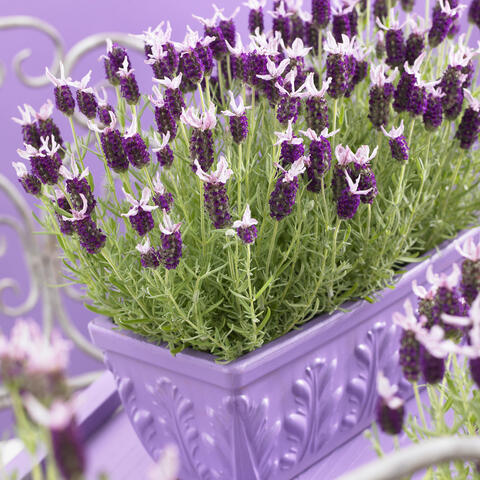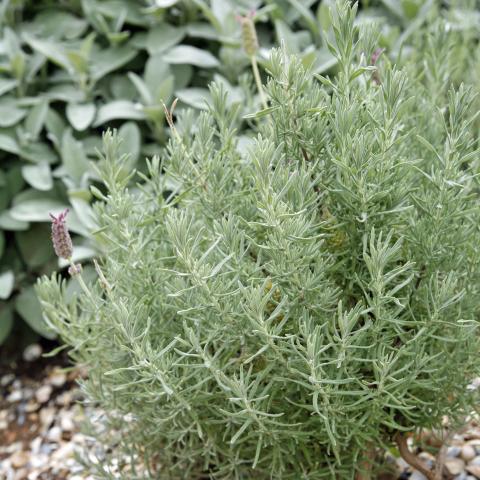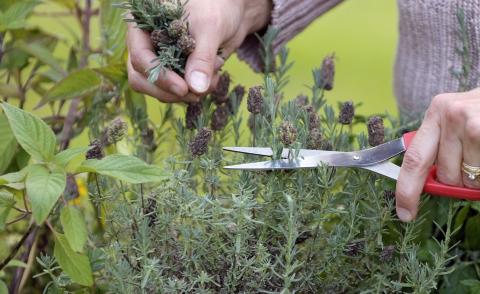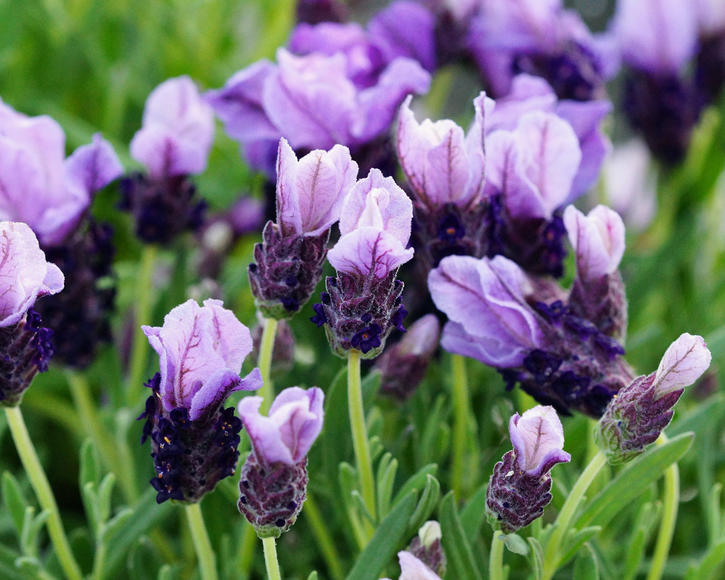Spanish Lavender
The fragrant Spanish Lavender (Lavandula stoechas) will bring fresh energy to the garden or the terrace with its bold blossoms.
Factsheet
- Growth type
-
- Dwarf shrub
- half shrub
- Growth height (from)
- from 50 cm to 100 cm
- Growth width (from)
- from 50 cm to 100 cm
- Growth characteristics
-
- bushy
- Flower color
-
- purple
- pink
- white
- Flowering time (month)
-
- May to September
- Flower shape
-
- Spike
- Fragrance
-
- 3
- Leaf color
-
- silver grey
- page format
-
- lancéolées
- needle-shaped
- Sheet properties
-
- evergreen
- Light
-
- sunny
- Soil type
-
- gravelly to sandy
- Soil Moisture
-
- moderately dry to fresh
- ph value
-
- neutral to acidic
- Lime compatibility
-
- sensitive to lime
- Nutrient requirements
-
- low in nutrients
- Humus
-
- low humus
- Decorative or utility value
-
- Flower Decoration
- Scented plant
- Nectar or pollen plant
- Toxicity
-
- non-toxic
- Winter Hardness
-
- frost-sensitive
- Use
-
- Flowerbeds
- Planters
- Winter garden
- Garden style
-
- Flower garden
- Roof Garden
- Pot garden
- Bee Friendly
- bee friendly plant
The Spanish Lavender (Lavandula stoechas) belongs to the family of the labiate family (Lamiaceae) and the English Lavender (Lavandula angustifolia). It originates from the coastal regions of the warm Mediterranean region, the Canary Islands and Madeira. It is more sensitive to frost than English Lavender and in our latitudes it must be potted throughout winter to keep it frost-free. It is often planted in a garden bed like an annual plant.
The Spanish Lavender is a bushy subshrub with an upright growth. Depending on the growth conditions, it grows about 39 inches tall and has almost the same width. The leafy shoots are heavily branched — resulting in a very compact appearance. The lavender is also called Butterfly Lavender because the petals spread out like the wings of a butterfly.

Spanish Lavender has leathery, evergreen, opposite leaves. They are about 1.57 inches long, lance-shaped and taper at both ends. Young leaves are silvery green in color, which later turn dark. The appearance and fragrance of the Spanish Lavender foliage is reminiscent of pine needles.
The Spanish Lavender has the most impressive blossoms of all lavender types. Below it, the Spanish Lavender has the typical fragrant, five to eight centimeters long mauve flower panicles with brown-colored, felt-like bracts. Depending on the species, the blooming period is between late May and early September. The blossoms’ scent is a little stronger than that of English Lavender and is reminiscent of camphor. In addition to the wild species with classic violet flowers, breeding has also resulted in pink and white lavender varieties.

Since it is a Mediterranean plant, Spanish Lavender needs a sunlit, secured location and at least four hours of sunshine per day. The concentration of the essential oils increases with a warmer and drier place, which in turn results in an intense fragrance. The soil should be slightly sandy and permeable and - unlike English Lavender - low in lime! The pH should be somewhere between an acidic to neutral environment. For planting in container, a lean potting soil-sand mixture, commercially available herbal or, cactus soil.
The best time to plant Spanish Lavender is mid-may, immediately after Ice Saints. Remove all the weeds from the plant bed before planting, since saplings are easy targets for weeds. Do not plant the Spanish Lavender so close to each other (planting distance about 30 centimeters) that rainwater dries out quickly. If the Spanish Lavender is planted as a container plant, terracotta pots are particularly suitable because excess water can evaporate easily and they blend visually with the lavender in a wonderful way. Planting in a balcony box is also possible.
A drainage layer made of foamed clay, gravel or broken glass prevents waterlogging. As a container plant, Spanish Lavender can adorn your home all year round. Always remove the Spanish Lavender from the pot you bought it in, because these pots tend to be too small for it to grow. Note: Young Spanish Lavender can be a bit slow in growing. Only after a few years does the summer bloomer show its full beauty - therefore, specimens cultivated in pots are usually showier than bedding plants, which are typically disposed of after one season.

Spanish Lavender is used to heat and drought and therefore only needs moderate watering. Since the plant cannot tolerate lime, it should be watered with tap water that is left to sit out for a long time, filtered water or rainwater. The soil of this Mediterranean plant should never be very damp. After watering the lavender, pour out water from the coasters.
To maintain the compact shape of the Spanish Lavender, trim the shoots to half after flowering. So it sprouts back to form a lush second bloom on the new wood. Make sure that the subshrubs do not penetrate into the more woody, perennial wood, only the shoot section with leaves will sprout properly. Regular pruning of withered flowers also stimulates the growth of new flowers. Avoid bark mulch and generous doses of fertilizers for the Spanish Lavender, it loves barren and airy mineral soils with low hummus, similar to the English Lavender. A moderate fertilization for budding in spring season is sufficient for Spanish Lavender.

Spanish Lavender is sensitive to frost and, if kept out in the open, can survive winter in very mild regions with good protection. To do this, it should be well rooted and must reach a certain size. It is also important that the soil is very permeable and does not get wet in winter. Use fleece or dry sticks to protect it from the cold and winter sun. During winter, young Spanish Lavender and potted plants must be kept in a bright place at forty-one to fifty Fahrenheit in the house. Frost-free, unheated rooms such as cold winter gardens, attics or bright storage rooms are well suited for this.
During winters Lavender requires very little water, but the soil should not dry out completely. Starting from February, the plant can slowly get used to warmer temperatures. After winter, between February and March, the plant should be trimmed back a bit and repotted to stimulate budding and flowering. During repotting, loosen the root web and slightly trim the roots. Water it after repotting.
Since the Spanish Lavender is not a winter hardy plant, it should be planted as a container or balcony plant. If planted in the garden, it adorns herb beds, Bed edging plants, Rock garden, Slopes or foreground of shrub beds in combination with gypsophilia, asters, or stonecrops where it acts as a bee pasture and attracts busy insects in large flocks. Spanish Lavender enhances a bouquet of flowers with its aroma. The flowers and stems of the lavender can be used in dried form for scented sachets and potpourris or for flavoring and decorating dishes, just the way you would use a English Lavender. The best time to harvest, is right before blossoming.

'Marshwood' is a variety with a particularly large and long-lasting bloom. The new variety of Spanish Lavender ‘Kew Red’, with white bracts sitting atop red flower heads, has an alluring fragrance. The ‘New Madrid’ series has large-flowered violet, red, pink and white varieties, unfortunately they only have a faint fragrance. On the other hand, the dark purple blooming 'Anouk' with silver-gray foliage is very fragrant. Tip: Lavenders are quite popular in England, where you get a wide variety to chose from.
Spanish Lavender can be propagated by sowing or cuttings. It is sown in seed trays in February. Gently press the seeds of the light-dependent germinators in the soil, cover with a little soil and moisten the surface with a spray bottle. The first shoots will appear after a week or two. The seedlings can be planted out after the last night frosts. In the bed, lavender often sows itself if the flowers are not removed before the seeds ripen.
To propagate the Propagation by cuttings young shoots with a length of 3.94 to 5.9 inches are cut off at the beginning of the budding in spring. The tops are removed, leaves in the lower area are removed and placed in a container with planting soil. A plastic film over the pot keeps the humidity constant and helps the cuttings to grow. Place the nursery pot in a bright and warm place, away from direct sunlight. If the cutting shows new leaves, it can be planted out. In good weather, cuttings can also be grown directly outdoors.
Most Spanish Lavender diseases are a result of planting mistakes such as a very wet substrate. In this case, there is a risk of mold and root rot. The essential lavender oils have a deterrent effect on most pests, so you need not worry about pest infestation.
Frequently asked questions
When to plant the Spanish Lavender?
The best time to plant the frost-sensitive Spanish Lavender is immediately after Ice Saints
How to maintain the Spanish Lavender?
Spanish Lavender should be watered moderately. Low lime rain water works best. As an alternative, filtered water or tap water that is left to sit out can be used. In the spring, the Spanish Lavender is happy with only moderate fertilization. Also, withered flowers must be removed periodically.
How long does the Spanish Lavender remain in bloom?
Depending on the variety, Spanish Lavender blooms from late May to early September.
When do you need to trim the Spanish Lavender?
After flowering, trim the lavender shoots by about half.
Can you overwinter a Spanish Lavender?
Winter lavender can be overwintered in a bright room at around forty-one to fifty degrees Fahrenheit. In areas that experience mild winters, larger and well-rooted plants do not need winter protection and can be kept outside during winter.
What goes well with Spanish Lavender?
Spanish Lavender look great in rock gardens, herb beds, bed edgings or embankments. Combine Spanish Lavender with ornamental allium, stonecrops, asters or gypsophila, to attract busy bees and other insects in the garden.

